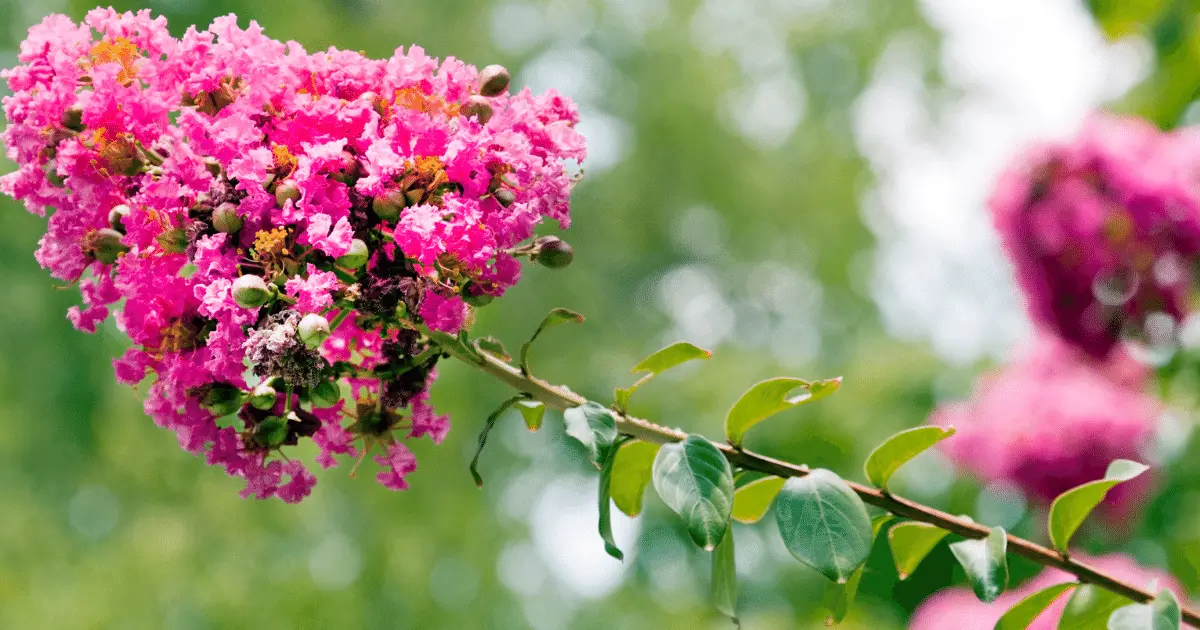Lagerstroemia or Crepe Myrtle plants, also called Crape Myrtles, are easily recognizable and well-liked for their unique, enduring, beautifully themed flowers and leaf colors. They often bloom all through Autumn to Summer, and when they do, the blossoms appear crumpled and feel like waffles, mostly in reddish, whitish, and purplish tints.
Myrtle Plants grow as speckled branches on channeled, well-developed stems with a deciduous outer layer. Their unembellished contrasting leaves are mostly lined and marginal, making them the perfect woody ornamental garden plants.
Propagating Crepe Myrtles

I find them particularly irresistible: they look so ebullient and exuberantly lavish, and their colorful blooms have many decorative, industrial, and medicinal applications. A major score point for them is their ease of propagation, requiring almost no special skills to succeed.
Propagation is also a great way to maintain the right sizes of your Crepe Myrtles to sustain their floral beauty. Some expert propagators advise that you prune and propagate your Crepe Myrtles yearly.
You can propagate them easily from stem cuttings, and they should be ready for propagation between early June and late September for quick results. You can also propagate them by growing their seeds in a pot, and I’ll be walking you through the methods involved now.
Propagating Crepe Myrtles from Stem Cuttings
Crepe Myrtles can be propagated via hardwood or softwood cuttings, and the process is quite similar in both cases. Softwood cuttings are usually the younger, fresher, greener stems just below the upper section of the growing plant; they’re usually the result of axillary growths during late spring.
The hardwood cuttings are the older parts of a grown stem from the previous resting season (Fall) that look woody due to the hardening of their cambium. There are also ‘in-between’ cuttings taken from stems that grew during the recent summer, called semi-hardwood cuttings.
Stems for cuttings are chosen based on their length (not less than 6 inches), several leaves (at least 2-3), and each having leaf nodes for axillary growth.
Preparing cuttings when the plant is actively growing between spring and summer is best. Make clean cuts of your chosen stems using your gardening scissors or knives and pluck off the leaves attached at the base, close to the cut edges.
Just locate a warm, dry surface to position them, and your cuttings will be ready for rooting once their wounds have healed completely, usually within 1-3 days. It is a waste of time to root Crape Myrtles in water; the chances of success are non-existent. It’s easier to root them in potting soil for quicker results.
Rooting your Crape Cuttings
Before rooting the cuttings, dip them in a rooting hormone to prevent the growth and spread of disease-causing microorganisms, especially if the cuttings got infected during cutting preparation or while it was healing. Some natural rooting hormones include honey, cinnamon, and willow water.
Pour some soil mix into the rooting pot and make tiny holes on the surface for the cuttings to fit in. Next, dab the cuttings into the rooting hormone from their cut edges before planting them in the soil mix potting, inserting each cutting in the hole.
More soil mix will be required to strengthen the cuttings in their new position before watering thoroughly, either by spraying or misting.
The younger plants should be kept under shade or behind a well-illuminated window to start receiving indirect sunshine daily. A trick I like to employ in maintaining the desired humidity factor for the pots is to cover them with a transparent plastic bag immediately after watering, and the excess water drains off.
You should only remove the plastic bag to water them repeatedly once every week. Crape Myrtle cuttings typically begin to root a month or two afterward.
You can also propagate Crape Myrtle seeds in a potting mix by pushing them into a Potting medium, watering them lightly, and covering them up using a plastic bag, just as you would a cutting.
Once your seeds and cuttings are well rooted or germinated, consider letting them grow in the same pot by removing the covering plastic bag or move them to a more permanent location.
Sunshine Requirements for Propagating Crepe Myrtle
Crepe Myrtles are very tenacious and relentless in their growing seasons. Their maintenance is not so stressful, and with the right care, an average plant can grow under the open brilliance of sunshine for up to 25 years, although there are rare varieties that can be maintained for over a hundred years.
They are interestingly ubiquitous because they’re adaptable to tropical and subtropical climates. As a modal symbol of love, beauty, and marriage longevity in most societies, they are low-maintenance plants that can be propagated with minimal monitoring.
These tropical flamboyant ornamental plants can be kept under shade, or indirect sunlight, especially during their growing seasons. Mature Crepe Myrtles need to be allowed to receive 6-7 hours of bright sunshine daily for up to a week to see them bloom.
Anything less and they may still bloom, but weakly so; their leaves and flowers begin to look weak, pale, and wilting when the available sunshine isn’t sufficient for them.
Best Potting Medium to Propagate Crepe Myrtle Plants

As you gradually begin working with these awesome selfless blooms, you’ll soon realize how easy and tolerable they are. One other area they manifest their tolerance is when choosing the right potting mix to propagate them.
They hardly have specific soil requirements and will thrive in a neutral or mildly acidic mix. If you wish to get a Potting Medium that’s best for their healthy growth, go for one with a pH range between 5.0 and 5.5, meaning one that’s gently acidic.
Unlike most Succulents I’ve worked on over the years, Crepe Myrtles can be propagated in regular garden soil and clay or sandy soil samples. As long as the soil mix is rich in organic substances and has good drainage and aeration, the Crepe Myrtles will pose no trouble.
Watering your Crepe Myrtles
Crape Myrtles like to get a good soak every time the soil mix feels dry up to 1 inch from its surface. Younger plants can be watered by misting and spraying, but the older ones prefer bottom watering.
It would help if you only water them once a week during spring and summer; buy for the winter season, water them once in 2-4 weeks. A great way to tell when it’s time for watering is to observe the soil surface’s dampness and only water when it seems dry enough.
I can easily tell when the pots are getting too much water, the leaves begin to look weak and soggy, and new shoots tend to break off easily. An overwatered pot appears damp all day and grows yellowish leaves over time.
Myrtle Plant Toxicity
Although a majority of the Myrtle plant varieties show varying degrees of toxicity to humans and animal pets, such as the Myrtle spurge, which is known to cause vomiting and diarrhea when their latex is consumed or contacted, the American Society for the Prevention of Cruelty to Animals has announced that Crepe Myrtles are perfectly safe for man and animals.
Crepe Myrtles are generally found in a wide range of industrial applications, including timber production in making furniture, building bridges, and railway creepers. Some varieties are known to produce chemical substances that can reduce skin bumps and inhibit the spread of disease-causing microorganisms.
They’ve been named in the treatment of Continuous heartburn, menstrual flow disorder, canker wounds, acne, and warts. Other medical applications include the treatment of tuberculosis, bronchitis, whooping cough, and other intentional and urinary disorders.
Moreover, a well propagated Crepe Myrtle pot grows quite faster than other similar garden plants, adding as much as 24 inches to its height annually. Their maximum growing potential is pegged at 20-25 feet, meaning it’ll take up to 5 – 10 years to fully mature; although the wait is nothing compared to their century-long lifespan.
